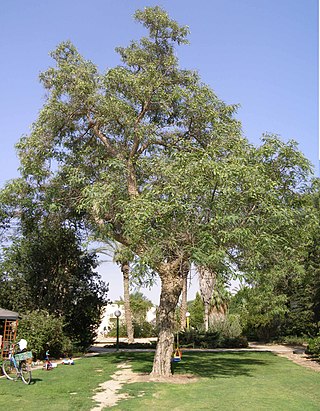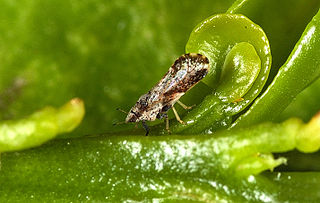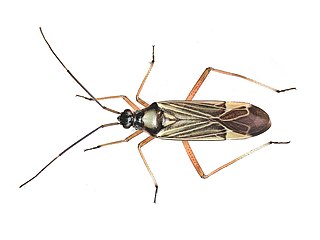
Reynoutria japonica, synonyms Fallopia japonica and Polygonum cuspidatum, is a species of herbaceous perennial plant in the knotweed and buckwheat family Polygonaceae. Common names include Japanese knotweed and Asian knotweed. It is native to East Asia in Japan, China and Korea. In North America and Europe, the species has successfully established itself in numerous habitats, and is classified as a pest and invasive species in several countries.

Citrus is a genus of flowering trees and shrubs in the rue family, Rutaceae. Plants in the genus produce citrus fruits, including important crops such as oranges, lemons, grapefruits, pomelos, and limes. The genus Citrus is native to South Asia, East Asia, Southeast Asia, Melanesia, and Australia. Various citrus species have been used and domesticated by indigenous cultures in these areas since ancient times. From there its cultivation spread into Micronesia and Polynesia by the Austronesian expansion ; and to the Middle East and the Mediterranean via the incense trade route, and onwards to Europe and the Americas.

Psyllidae, the jumping plant lice or psyllids, are a family of small plant-feeding insects that tend to be very host-specific, i.e. each plant-louse species only feeds on one plant species (monophagous) or feeds on a few closely related plants (oligophagous). Together with aphids, phylloxerans, scale insects and whiteflies, they form the group called Sternorrhyncha, which is considered to be the most "primitive" group within the true bugs (Hemiptera). They have traditionally been considered a single family, Psyllidae, but recent classifications divide the group into a total of seven families; the present restricted definition still includes more than 70 genera in the Psyllidae. Psyllid fossils have been found from the Early Permian before the flowering plants evolved. The explosive diversification of the flowering plants in the Cretaceous was paralleled by a massive diversification of associated insects, and many of the morphological and metabolic characters that the flowering plants exhibit may have evolved as defenses against herbivorous insects.

In biology, a lerp is a structure of crystallized honeydew produced by larvae of psyllid bugs as a protective cover. These animals are commonly referred to as lerp insects, of which there are over 300 species in Australia.

Coextinction and cothreatened refer to the phenomena of the loss or decline of a host species resulting in the loss or endangerment of an other species that depends on it, potentially leading to cascading effects across trophic levels. The term originated by the authors Stork and Lyal (1993) and was originally used to explain the extinction of parasitic insects following the loss of their specific hosts. The term is now used to describe the loss of any interacting species, including competition with their counterpart, and specialist herbivores with their food source. Coextinction is especially common when a keystone species goes extinct.

Colophospermum mopane, commonly called mopane, mopani, balsam tree, butterfly tree, or turpentine tree, is a tree in the legume family (Fabaceae), that grows in hot, dry, low-lying areas, 200 to 1,150 metres in elevation, in the far northern parts of southern Africa. The tree only occurs in Africa and is the only species in genus Colophospermum. Its distinctive butterfly-shaped (bifoliate) leaf and thin seed pod make it easy to identify. In terms of human use it is, together with camel thorn and leadwood, one of the three regionally important firewood trees.

Citrus greening disease is a disease of citrus caused by a vector-transmitted pathogen. The causative agents are motile bacteria, Liberibacter spp. The disease is vectored and transmitted by the Asian citrus psyllid, Diaphorina citri, and the African citrus psyllid, Trioza erytreae, also known as the two-spotted citrus psyllid. It has no known cure. It has also been shown to be graft-transmissible. Three different types of HLB are currently known: the heat-tolerant Asian form, and the heat-sensitive African and American forms. The disease was first described in 1929 and first reported in China in 1943. The African variation was first reported in 1947 in South Africa, where it is still widespread. Eventually, it affected the United States, reaching Florida in 2005. Within three years, it had spread to the majority of citrus farms. The rapid increase in this disease has threatened the citrus industry not only in Florida, but the entire US. As of 2009, 33 countries have reported HLB infection in their citrus crop.

The bell miner, commonly known as the bellbird, is a colonial honeyeater, endemic to southeastern Australia. The common name refers to their bell-like call. 'Miner' is an old alternative spelling of 'myna', and is shared with other members of the genus Manorina. The birds feed almost exclusively on the dome-like coverings, referred to as 'bell lerps', of certain psyllid bugs that feed on eucalyptus sap from the leaves. The psyllids make these bell lerps from their own honeydew secretions in order to protect themselves from predators and the environment.
Ctenolophon is the only genus in the flowering plant family Ctenolophonaceae. It has two recognized species:

Tipuana tipu, also known as tipa, rosewood and pride of Bolivia, is a South American tree.
"Candidatus Carsonella ruddii" is an obligate endosymbiotic Gammaproteobacterium with one of the smallest genomes of any characterised bacteria.

Eucalyptus robusta, commonly known as swamp mahogany or swamp messmate, is a tree native to eastern Australia. Growing in swampy or waterlogged soils, it is up to 30 m (100 ft) high with thick spongy reddish brown bark and dark green broad leaves, which help form a dense canopy. The white to cream flowers appear in autumn and winter. The leaves are commonly eaten by insects, and are a food item for the koala. It is an important autumn-winter flowering species in eastern Australia, and has been planted extensively in many countries around the world. Its timber is used for firewood and in general construction.

Pachypsylla is a genus of psyllids. Species of the genus Pachypsylla lay eggs on the leaves of the Celtis occidentalis tree. Upon hatching, the young psyllids become encased in a gall which the young leaf parts grow in response to the infestation.

Diaphorina citri, the Asian citrus psyllid, is a sap-sucking, hemipteran bug in the family Psyllidae. It is one of two confirmed vectors of citrus greening disease. It has a wide distribution in southern Asia and has spread to other citrus growing regions.

Liberibacter is a genus of Gram-negative bacteria in the Rhizobiaceae family. Detection of the liberibacteria is based on PCR amplification of their 16S rRNA gene with specific primers. Members of the genus are plant pathogens mostly transmitted by psyllids. The genus was originally spelled Liberobacter.

Acizzia solanicola is a psyllid from Australia, found on plants of the genus Solanum. It has subsequently been found also in New Zealand.

Spondyliaspidinae is a bug subfamily in the family Aphalaridae. Plant eaters, they primarily feed on eucalypts.

Cardiaspina fiscella, the brown basket lerp or brown lace lerp, is a jumping plant louse species in the genus Cardiaspina originally found in Australia. It spread to New Zealand where it was found in 1996 near the Auckland airport. It feeds on eucalyptus, especially swamp mahogany, and is found in Victoria, eastern New South Wales, and southeastern Queensland, as well as the capital territory (ACT) around Canberra and on Norfolk Island. Cardiaspina fiscella has five nymphal instars, and as the instars moult they add a layer to their outside covering (casing), known as the "lerp".

Miris striatus is a Palearctic species of bugs that constitutes the type species of the type genus of the family Miridae. It has been reported to be a predator of psyllids such as Cacopsylla melanoneura.
















